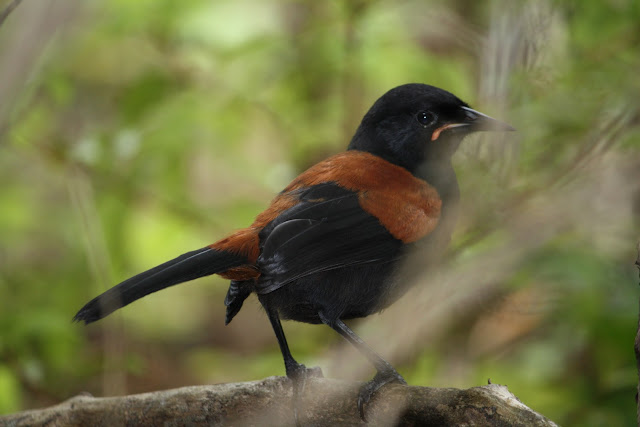We met a few local cruising boats in Kawau and they told us about an island loaded with birds that should not be missed. Although it meant we had to backtrack a couple of hours south, we had the time and decided to check it out. We were glad we did.
 |
| New Zealand Pigeon |
 |
| Juvenile Tui |
Tiritiri Matangi Island (commonly referred to as "Tiri") is a wildlife sanctuary, and one of New Zealand's most important conservation projects. It is located 30 km north east of central Auckland and just 4 km from the end of the Whangaparaoa Peninsula. 120 years of farming had seen this island stripped of 94% of its native bush but between 1984 and 1994, volunteers planted between 250,000 and 300,000 trees. The island is now 60% forested with the remaining 40% left as grassland for species preferring open habitat.
 |
| North Island Saddleback |
 |
| North Island Saddleback |
In conjunction with this planting programme, all mammalian predators were eradicated and a number of threatened and endangered bird and reptilian species have been successfully introduced including the flightless takahe, one of the world’s rarest species, and the tuatara. Nowhere else in New Zealand can you readily see and walk amongst so many rare species.
 |
| Whitehead |
The Little spotted kiwi, Brown teal, Takahe, Red-crowned parakeet, Whitehead, North Island robin, Stitchbird, North Island kokako, North Island saddleback, Fernbird, and the North Island tomtit are all endemic to New Zealand and were translocated to Tiritiri Matangi.
 |
| Fantail |
Most years Tiritiri Matangi is visited by a pair of Paradise Shelduck who nest and raise their young then disappear again for another year and we were lucky to see them.
A Takahe was wondering around the lighthouse and has brown eyes, a scarlet red bill and shield massive, with red legs and feet. The plumage ranges from an iridescent dark blue head, neck and breast and peacock blue shoulders to olive green and blue back and wings. They do have wings despite being flightless. The white undertail flicked with every step. The bill and shield are scarlet, the eye red and the legs and feet are orange – red.,
The Takahe was thought to be extinct until the rediscovery of 250 birds in the Murchison Mountains of Fiordland in 1948. Since then their numbers surviving in the wild have declined, fluctuating between 110 and 160 birds. The low success rate in breeding is due partly to the high rate of egg infertility, about 40%. Breeding is closely monitored and 'extra' eggs beyond one per clutch are removed and given to another takahe to incubate. Surplus eggs go a Rearing Unit where the chicks are fed by puppets and raised for return to the wild.
 |
| New Zealand Bellbird |
There were miles of elaborate wooden walkways winding through the forest and several spots with feeding or bathing stations where long, comfortable benches were constructed to sit quietly and watch the action. All along the paths, the native trees and ferns were identified and plaques were placed with information about them and the types of birds that are normally seen nearby. It was really well done and all for free for those of us with boats to get there. The “dirt dwellers” had to come by ferry.
 |
| Red Crowned Parakeet |
My Uncle Joe would have loved it here. He volunteers at a similar sanctuary on Cape Cod back in the states and would appreciate the wildlife and all the efforts taken to make it accessible to the public. Only one night here and off in the morning to Whangarei where we are scheduled to be hauled out for periodic bottom paint. They will haul us out of the water and up a ramp on a cradle which will be new to us. Normally we are lifted with slings. We shall see how that goes…
Tom






2 comments:
Is this an April Fools joke? Weird birds! Seriously, a very interesting sanctuary. The only bird familiar to me is the oystercatcher, which you showed on an earlier post. It's very similar to the species we have here on "Olde Cape Cod".
Best to the crew - Uncle Joe
Really great photos! I'm glad you went back too.
Post a Comment